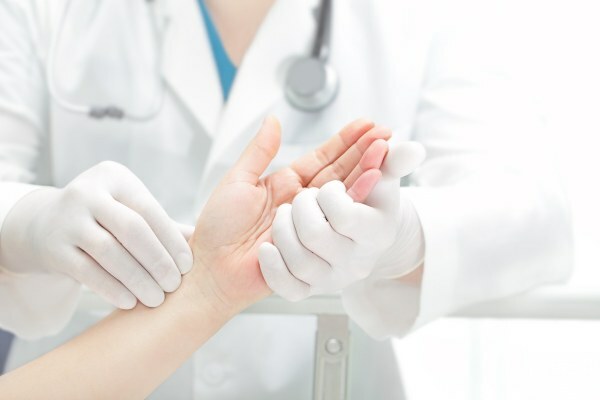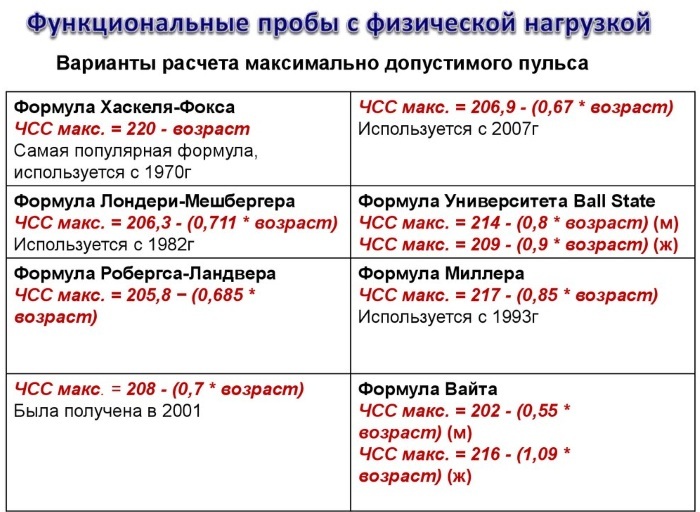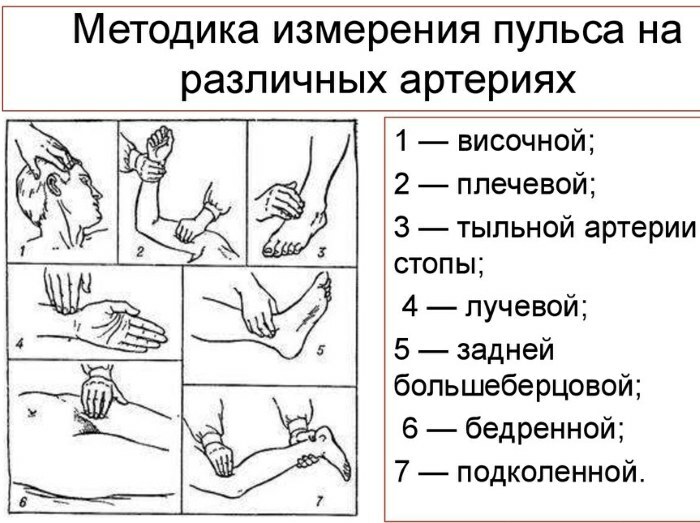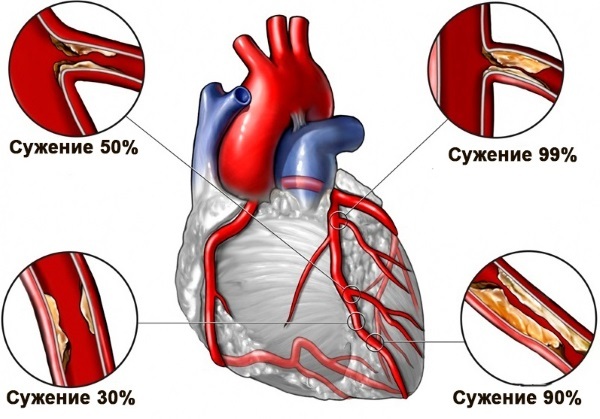Pulse rate in an adult - the indicator is individual. In men and women, it can change depending on age. The rate of rhythmic movement depends on the state of the cardiovascular, nervous system and other physiological factors.
Record content:
- 1 What determines the frequency of heartbeat in an adult?
-
2 Heart rate by age
- 2.1 Among women
- 2.2 In men
- 3 Norms of heart rate in adults during sleep, wakefulness
- 4 Heart rate at rest, walking, running, training
- 5 How to measure your heart rate correctly? Algorithm of the procedure
- 6 Symptoms of a malfunctioning heart rate
- 7 Natural causes of tachycardia in humans
- 8 Pathological causes
- 9 Normal heart rate video
What determines the frequency of heartbeat in an adult?
Pulse fluctuations make it possible to characterize the work and state of the heart in an adult. The rate varies between 60-100 beats. When contracted, the muscular organ creates a wave. It is usually found in the radial and carotid arteries. If a person does not suffer from heart disease, then the pulse and heart rate are equal.
They can be affected by the following factors:
- Bad habits. People who regularly abuse alcohol, energy, caffeine containing beverages and tobacco, pulse above.
- Age. In adults, compared with a teenager, the heart beats slower.
- Pregnancy, obesity. During the period of gestation and in the presence of excess weight, the frequency of the pulse wave increases.
- Temperature. If there are jumps in temperature up or down, then it will affect the heart rate. The higher the temperature, the faster the tempo.
- Physical state. If a person avoids regular sports, then his pulse slows down.
- Psycho-emotional background. The negative and positive emotions that one experiences during times of stress can contribute to an increase in heart rate.
- Body position. In the supine position in an adult, the pulse is reduced.
-
The influence of the external environment. An increase in heart rate can be triggered by high humidity and air temperature.

The frequency of the pulse wave can be affected by a number of pathological reasons, which include:
- Paroxysmal tachycardia. The increase occurs suddenly. The attack goes away on its own.
- Respiratory dysfunctions. An increase in heart rate is observed with emphysema, pulmonary obstruction and other pathologies accompanied by respiratory failure.
- Heart disease. Defects, myocardial infarction, hypertension, coronary heart disease lead to abnormalities in the pulse.
Tachycardia is also possible during fever.
Heart rate by age
The pulse rate in an adult (women and men have equal rates) is 65-85 beats. The indicator may vary depending on the age and gender of the patient. Measure it in several ways.
Among women
In children and adolescents, the heart rate is 70 - 170 beats. This is due to the size of the heart: the muscular organ is small enough, so it needs more activity to pump blood. For girls under 30, the norm does not exceed 150-160 strokes. In women over 35 (up to 45) years old, deviations of 15-20 units are possible.
Age norms:
| Age | Indicators (sp. in min.) | The maximum possible values (beats. in min.) |
| 13-18 years old | 60-80 | 130-150 |
| 18-25 years old | 65-95 | 150-170 |
| 25-30 years old | 70-90 | 160-180 |
| 30-45 years | 75-95 | 150-180 |
| 45-60 years | 70-90 | 160-185 |
| 60-75 years | 75-85 | 150-170 |
| 75 years and above | 65-80 | 130-160 |
If the increase or decrease in the pulse is systematic, regardless of the condition, time of day and age, then the patient must consult a doctor. Fluctuations may indicate the development of pathologies of the cardiovascular system.
During pregnancy, a fundamental restructuring of the female body occurs. In the early stages, the heart rate is 70-85 beats. As the fetus forms and grows in the womb, the indicators increase: in the second trimester, there is an increase of 5-10 units, in the third trimester - by 15-20 units.
In men
Boys and young men metabolic processes are more active, so the pulse in children and adolescents is higher than that of adult males. Indicators may vary depending on the fitness of the person: during intense exercise strengthens the myocardium, which promotes the release of a larger volume of blood.

Norms:
| Age | Indicators (sp. in min.) | The maximum possible values (beats. in min.) |
| 15-20 years old | 60-70 | 130 |
| 20-30 years | 65-75 | 130 |
| 30-45 years | 65-80 | 150 |
| 45-60 years | 70-80 | 120 |
| 60-75 years | 65-70 | 110 |
| 75-85 years | 60-70 | 100 |
| 85 and above | 50-65 | 90 |
The decrease in heart rate in older men may be caused by pathological changes in the body. In a healthy human figure it should not exceed 100 beats per minute.
Norms of heart rate in adults during sleep, wakefulness
The pulse rate in an adult (women and men usually have the same indicators) during wakefulness and sleep can differ. The frequency must be measured while the patient is at rest. During the night, 4-6 sleep cycles are replaced, each of which lasts 90 minutes.
In 6-9% of adults, heart rate decreases at night while sleeping. The following factors can influence changes:
- increased tone of the parasympathetic nervous system (vagal, "vagus" nerve);
- decreased functional activity of the brain (only basic signals are sent to the heart);
- decrease in body temperature;
- slowing down the metabolism;
- lack of physical activity.

Also, the indicators can be affected by:
- conflicts that occurred immediately before going to bed;
- watching TV programs with an exciting plot;
- taking medications that increase the heart rate;
- menopause;
- the period of gestation (regardless of the trimester);
- hormonal failure that occurred against the background of a decrease in the functional activity of the pituitary gland, hypothalamus, adrenal cortex or thyroid gland;
- dystonia of the neurocirculatory type;
- neuroses, depression;
- disorders of functional activity, liver, kidneys and cardiovascular system;
- diseases of infectious etiology;
- sleep apnea, snoring, sudden respiratory arrest;
- pain caused by mechanical injury;
- disturbing dreams;
- lack of oxygen in the room;
- temperature drop;
- the use of caffeine, energy, alcoholic beverages and tobacco products just before bedtime;
- binge eating.
In children and adults, minor deviations of 5-15 units are considered the norm. In women, the pulse should not fall below 40-45 beats. For men, at least 50 and no more than 70 strokes are considered the norm. The fall is observed at 3.30-4.00 am. During deep sleep, your heart rate usually slows down.
Heart rate at rest, walking, running, training
The pulse rate in an adult (women, men and the elderly can have individual physiological indicators) during physical activity increases by 20-30 units. To determine the optimal load on the heart, during exercise, the pulse is calculated at the time of physical activity.
If a person goes in for sports with a recreational purpose, then he needs to subtract his age from the number 220. The optimal value will be 50-60% of the resulting figure.

It is necessary to calculate the pulse if a person suffers from diseases of the cardiovascular system. He needs to individually select the load.
A workout is considered competently carried out if the pulse has been measured several times:
- in 10 minutes before the start of the workout;
- after warm-up;
- after the main part of the workout;
- at the end of the workout.
Indicators may vary depending on the type of load. Is it normal for professional athletes to increase up to 75-90%? At rest, the heart rate in an adult is 60-70 beats per minute. With strength training, there is an increase in heart rate up to 95%. The pulse before the next approach should recover on its own.
The person should not have discomfort in the left side of the chest or shortness of breath. Walking is considered the most optimal way to train the myocardium. The optimal indicator is 50-60% of the possible permissible norm. For men and women involved in race walking, 85-100 strokes are considered the norm.
When jogging, swimming or cycling, it is also important to monitor your heart rate. Experts say that training in which the heart rate is kept in the range of 120-140 beats per minute will be most effective.
In old age, experts do not recommend intensive training. It is necessary to regularly monitor the pulse, especially if a person suffers from arrhythmia or angina pectoris. He is given a stress ECG while exercising on a treadmill or stationary bike.
How to measure your heart rate correctly? Algorithm of the procedure
The pulse rate in adult men and women is determined by palpation. You can also use special devices.

Before measuring, it is necessary to determine the places in a person where the pulse is well felt:
| Zones | Location of blood vessels |
| Armpit | The pulse is felt in the axillary artery. |
| Forearm | In the area of the forearm next to the biceps, the brachial artery passes. |
| Wrist | The radial artery is located on the inside of the wrist. |
| Outer wrist | The pulse is felt at the ulnar artery. |
| Thigh area (groin) | The femoral artery is located on the inner side of the thigh. |
| Neck area | The carotid arteries (paired) run along the right and left side of the neck. |
| Temple | An artery is located above the eyebrow, in the region of the temporal bone. |
The pulse can be measured independently without the help of specialists. To do this, you need to find a place where the pulse is well felt. Most often, the areas where the popliteal, femoral, temporal, carotid, brachial and ulnar arteries lie are palpated.
If you experience rapid heartbeat, the pulse can be measured and on the finger. The carotid artery is responsible for the delivery of blood to the brain, therefore, most often the heart rate is measured using it.
Algorithm of actions:
- 2 fingers (index and middle) of the right hand are folded together;
- they are applied to the Adam's apple, lowered down to the fossa in the neck;
- measured pulse for 60 seconds.
Before the procedure, you must prepare a stopwatch or clock. Measurements are taken in a relaxed position, for this you need to sit down on a chair and lean back on its back. You can also calculate your heart rate by placing your palm on your left side of your chest. In men, the pulse is most accurately felt under the left nipple, in women - under the left breast. Algorithm of actions.
Necessary:
- get rid of outerwear;
- take a recumbent position;
- turn on the stopwatch;
- put your hand on your left chest;
- count the number of beats in 60 seconds.
The pulse is also measured at the wrist: the radial artery passes through this zone.
Algorithm of actions:
- take a sitting position and completely relax;
- turn the left hand palm up;
- put the index and middle finger of the right hand together, applying it to the inside of the wrist;
- turn on the stopwatch and measure the pulse.
It is preferable to measure the heart rate on the left hand. On the right side, the readings may deviate slightly from the norm.
Heart rate is also measured using a tonometer or pulse oximeter. The devices give a fairly accurate result. In addition to the number of strokes, the devices help measure blood pressure and the degree of oxygen saturation in the blood.
Symptoms of a malfunctioning heart rate
Violation of the heart rhythm may indicate the development of a number of diseases characterized by a decrease in the functional activity of the vascular system and myocardium.
In addition to an increased heart rate, patients may complain of the following ailments:
- shortness of breath, appearing at rest or with minimal physical exertion;
- Painful pulse in the forearm, wrist, or carotid artery
- severe dizziness, even fainting;
- darkening in the eyes;
- decrease in the quality of vision;
- fatigue, general weakness;
- lack of interest in the people around;
- pain in the left side of the chest, usually pressing or stabbing;
- lack of air.
The accompanying symptoms of tachycardia can also include:
- convulsions;
- decreased urine volume;
- complete or partial loss of appetite;
- sleep disturbance.

If several of the above symptoms appear at the same time, the patient needs to provide first aid in a timely manner.
Natural causes of tachycardia in humans
The pulse rate in an adult (women and men are equally susceptible to pathologies) can increase spontaneously. Tachycardia of a physiological type occurs as a result of the active influence on the human body of a number of factors (inappropriate climatic conditions, medication, stress). Under their influence, an increase in heart rate is observed.
Natural causes of tachycardia include:
- bites (the pulse often quickens after the poison of animal origin enters the body);
- attacks of pain (toothache, migraine, intestinal colic);
- congenital diseases;
- dehydration;
- drinking a lot of drinks that contain taurine, caffeine or alcohol;
- poisoning with medicines, chemicals or other poisonous substances;
- long-term use of drugs that stimulate the sympathetic nervous system (norepinephrine, adrenaline, nootropics, antihypertensive drugs, diuretics, anesthetics, cardiac glycosides);
- violation of the functional activity of the endocrine system (pheochromocytoma, hyperthyroidism);
- diseases of infectious etiology, accompanied by an increase in temperature (tuberculosis, pneumonia, tonsillitis, sepsis, vegetative-vascular dystonia);
- disorders of the brain and subcortical nodes;
- prolonged stay in stressful situations;
- a sharp change in body position from vertical to horizontal and vice versa;
- exhausting physical activity.

In some cases, tachycardia occurs due to unexplained reasons. Most often, the pathology is characterized by rapid heart rate and impairment of mental and emotional background.
Pathological causes
Increase or decrease in heart rate can be triggered by the occurrence of pathological changes occurring within the organism.
These include:
- Hypothyroidism or hyperthyroidism. In the first case, a hormone deficiency, in the second - an overabundance of substances produced by the thyroid gland. The pathology is accompanied by violation of the functional activity of the heart and blood vessels. For hypothyroidism is characterized by tachycardia, hyperthyroidism - slowing of the pulse. In the absence of adequate treatment of high risk of disability in humans. In severe cases may lead to death.
- Diabetes. The pathology is characterized by impaired functional activity of most of the internal organs and systems. Most wear the heart. In the absence of adequate treatment of people die 9-12 years ahead of schedule. Type I diabetes treatment can not be. Specialist selects corrective and supportive medical therapy, allows you to restore the functioning of internal organs. In diabetes there is a thickening of the vascular walls, which leads to disruption of blood flow.
- Pheochromocytoma. The tumor is usually localized in the adrenal glands. It consists of chromaffin cells. The disease is manifested drop in blood pressure and increased heart rate. The pathology is diagnosed in 1-2 people in 1000.
- Heart failure. Pathology can cause coronary disease. During congestive failure, there is an increase in heart rate up to the critical exponents. The absence of drug therapy is fraught with heart attack. The pathology is characterized by shortness of breath, swelling, caused by an overflow of blood vessels. The patient often complains of lack of air, especially during sleep.
- Acute ischemia. The disease is extremely dangerous. The lethal outcome is observed in 40-50% of cases. Attack characterized by rapid heart rate, pain in the heart and the rapid deterioration of the patient's state of health. In acute myocardial deficiency blood clot blocks blood flow, which leads to death of muscle cells in the background of oxygen starvation.
Cranial centers arises from vertebrobasilar insufficiency or degenerative disc disease. The patient is disturbed heart rhythm on a background of vertebral displacement or hernia growth. The artery is compressed, so blood flow is partially blocked. When tumors of the brainstem 100% of death recorded. Surgery is contraindicated.
Pulse rate adult should be measured regularly. Any deviations from the norm in men and women serve as a pretext for treatment in a medical facility. If there are associated symptoms (vertigo, dyspnea, shortness of breath, frequent yawning) assigned specialist medication after detecting the exact cause.
Normal heart rate video
Which pulse is normal and which is hazardous to health:



